Simple Laravel 11 CRUD Application Tutorial
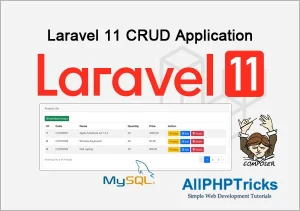
In this tutorial, we will learn about Laravel 11 CRUD application by developing a complete Laravel 11 CRUD application system with step by step and simple guide.
Although, this CRUD operations tutorial is for Laravel 11. However, it will also work on the previous versions of Laravel such as Laravel 10, Laravel 9 and Laravel 8 as well.
In this example, we will use the Laravel 11 with the latest Bootstrap 5.3.2 version.
To install Laravel 11, you will need at least PHP 8.2 version, if you do not have PHP installed then you can download and install XAMPP to get the PHP, Apache and MySQL.
Before start developing Laravel 11 CRUD application, first let understand what are Laravel and CRUD operations.
Readers Also Read: Laravel 11 Custom User Registration and Login
What is Laravel?
Laravel is the most popular PHP application framework for building dynamic and modern web applications. It uses the model–view–controller (MVC) architectural pattern for building application.
One of the prominent feature of Laravel is Eloquent. It is an object-relational mapper (ORM) which enables the developers to interact with the database efficiently.
When using Laravel Eloquent, each table uses the Model that interact with the database table to perform the CRUD (create, read, update and delete) operations in it.
What is CRUD?
CRUD is just a acronym for Create, Read, Update, and Delete. These are the four essential operations of persistent storage.
These operations are mainly used in the relational (SQL) or no-SQL databases.
CRUD operations are essential for any application, almost all application uses databases to storing records, fetching existing records, updating existing records and deleting records.
Laravel Eloquent provides a convenience and easy way to interact with database and perform all CRUD operations.
Prerequisites of Laravel 11 CRUD App
To develop Laravel 11 CRUD application, ensure that you have already installed the following:
Application Flow:
In this Laravel 11 CRUD example, we will create a simple products table and perform all CRUD operations in it.
In this tutorial, we will store all product details in 5 columns which are product code (varchar), name (varchar), quantity (int), price (decimal) and description (text).
We can use 1 or 2 column table but we are using 5 columns tables intentionally to show you how to add different data types of records in table.
So that you can understand how to create migration of different data types and store data of these specific data types.
We will add, view, update and delete products from database.
Following are the screenshots of the Laravel 11 CRUD application which store, view, update and delete product from products table.
Product List Page
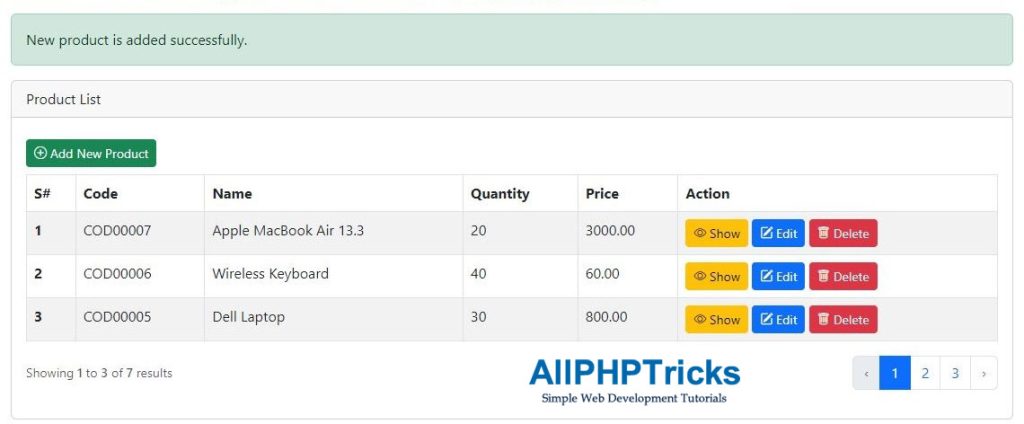
Add New Product Page
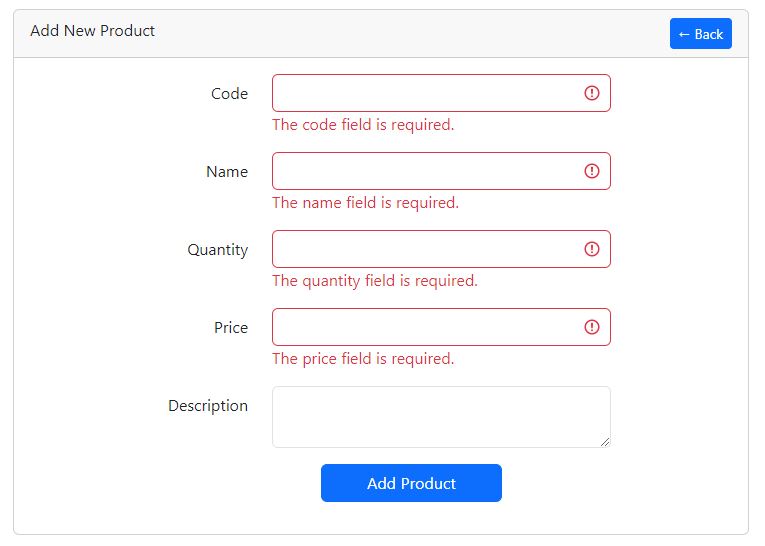
Edit Product Page
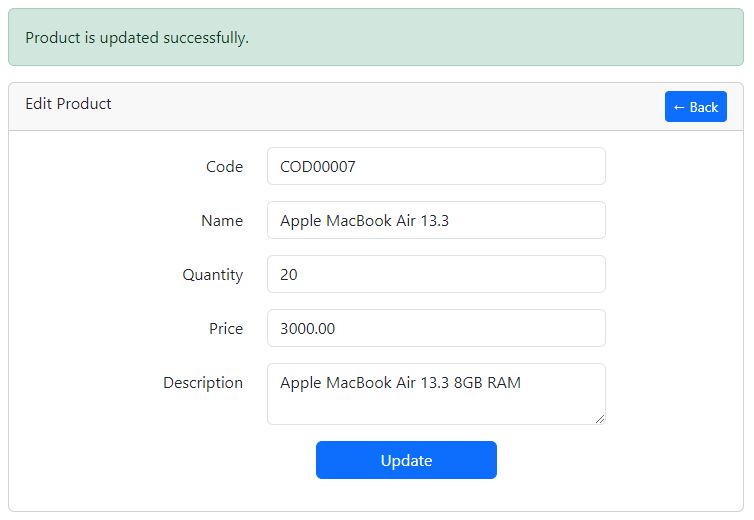
Show Product Page
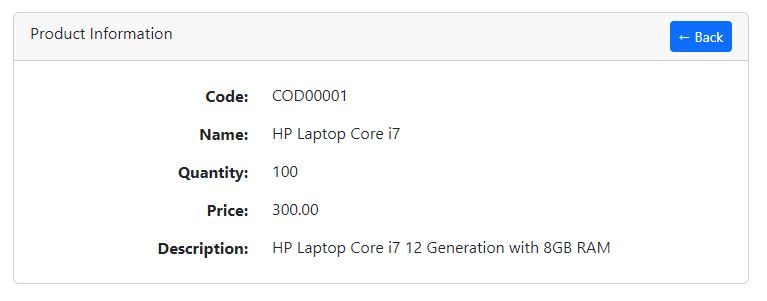
Readers Also Read: Laravel User Roles and Permissions
Without further delay, lets start developing a Laravel 11 CRUD application with simple product table example.
Steps to Create Laravel 11 CRUD Application
Follow the below step by step guide to create a Laravel 11 CRUD application.
- Install Laravel 11 App
- Create and Configure Database Credentials
- Create a Model with Migration, Resource Controller and Requests for Validation
- Update Product Migration
- Migrate Tables to Database
- Define Product Resource Routes
- Update Code in Product Model
- Update Code in Product Controller
- Update Code in Product Store and Update Requests
- Enable Bootstrap 5 in AppServiceProvider
- Create Layout and Product Resource Blade View Files
- Run Laravel Development Server
1. Install Laravel 11 App
Open the command prompt/terminal window and go to the directory where you want to install the Laravel 11 CRUD application. For example like below.
cd desktop\workspaceNow install the Laravel 11 application with name laravel_11_crud by running the below command on your terminal window or command prompt.
composer create-project laravel/laravel:^11.0 laravel_11_crudAfter Laravel 11 installation, navigate to the newly created directly by running the below command.
cd laravel_11_crud2. Create and Configure Database Credentials
In this step, first we need to create a database and then configure database credentials for Laravel 11 CRUD application.
To create a new database, we need to start the Apache and MySQL servers in the XAMPP control panel like below.
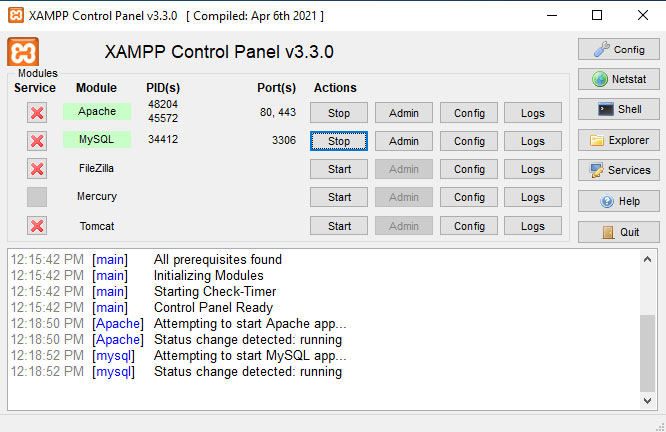
Then follow the below steps to create a new database and configure database in Laravel.
i) Open http://localhost/phpmyadmin/ in your web browser.
ii) Click on Databases menu in the top left side menu.
iii) Enter your database name such as laravel_11_crud and click on Create button.
iv) Open the .env file which is available in the Laravel application root directory and enter your own database credentials details.
The default user of MySQL in XAMPP is root and password is empty.
Database Credentials:
DB_CONNECTION=mysql
DB_HOST=127.0.0.1
DB_PORT=3306
DB_DATABASE=your_db_name
DB_USERNAME=your_db_username
DB_PASSWORD=your_db_password
DB_COLLATION=utf8mb4_unicode_ciBy default Laravel 11 comes with the database collation as utf8mb4_0900_ai_ci, which might create an issue when migrating tables to database therefore we also added the DB_COLLATION with value as utf8mb4_unicode_ci in our database credentials to avoid errors.
3. Create a Model with Migration, Resource Controller and Requests for Validation
In this step, we need to create a Model, Migration, Resource Controller and Requests for Validation of products table.
Although, we can create them individually, but we can also create them using a single artisan command.
Just run the below command on your terminal:
php artisan make:model Product -mcr --requestsIn the above command –m flag refers to a migration of the Model, cr flag refers to a resource controller, and — requests flag refers to the custom requests for resource controller.
It will create two requests, store and update requests for validation.
You will get the following message on your terminal after running the above command.

4. Update Product Migration
Now, we need to update a product migration file, just go to the directory laravel_11_crud\database\migrations and there you will see the product migration file like below.
YYYY_MM_DD_TIMESTAMP_create_products_table.php
Open this file and paste the following code in it.
<?php
use Illuminate\Database\Migrations\Migration;
use Illuminate\Database\Schema\Blueprint;
use Illuminate\Support\Facades\Schema;
return new class extends Migration
{
/**
* Run the migrations.
*/
public function up(): void
{
Schema::create('products', function (Blueprint $table) {
$table->id();
$table->string('code')->unique();
$table->string('name');
$table->integer('quantity');
$table->decimal('price', 8, 2);
$table->text('description')->nullable();
$table->timestamps();
});
}
/**
* Reverse the migrations.
*/
public function down(): void
{
Schema::dropIfExists('products');
}
};5. Migrate Tables to Database
Once the product migration file is updated, now we need to migrate all tables into our database.
Run the below artisan command on the terminal to migrate all tables into database.
php artisan migrate6. Define Product Resource Routes
Now in this step, we will need to define our application product resource routes in web.php. Just copy and paste the below code in your routes/web.php file.
<?php
use Illuminate\Support\Facades\Route;
use App\Http\Controllers\ProductController;
Route::get('/', function () {
return view('welcome');
});
Route::resource('products', ProductController::class);After defining the application routes, check the application routes by running the below artisan command on the terminal.
php artisan route:list
By running above artisan command, you will see all your routes like below screenshot:

7. Update Code in Product Model
Now, we need to allow mass assignment in Product Model file, just go to the app\Models\Product.php and update the following code in Product.php file.
<?php
namespace App\Models;
use Illuminate\Database\Eloquent\Factories\HasFactory;
use Illuminate\Database\Eloquent\Model;
class Product extends Model
{
use HasFactory;
protected $fillable = [
'code',
'name',
'quantity',
'price',
'description'
];
}In the above code, we are passing column names to protected $fillable array to enable mass assignment of these fields, otherwise Laravel will not add records into products table if we use the Laravel Eloquent to add data.
8. Update Code in Product Controller
Now in this step, we need to update our Product Resource Controller which contains sever (7) different methods to perform Laravel eloquent CRUD operations in our Laravel 11 CRUD application.
By default, the resource controller comes with the following methods. We will use these all methods for our Laravel 11 CRUD App.
- index() -> To list or display all of our products from products table.
- create() -> To display add new product form.
- store() -> To store our new product form request data into our products table.
- show() -> To display a single product with details.
- edit() -> To display a product edit form.
- update() -> To update the product data into our products table.
- destroy() -> To delete the product from the database.
Simply copy and paste the below code in app\Http\Controllers\ProductController.php file.
<?php
namespace App\Http\Controllers;
use App\Models\Product;
use App\Http\Requests\StoreProductRequest;
use App\Http\Requests\UpdateProductRequest;
use Illuminate\View\View;
use Illuminate\Http\RedirectResponse;
class ProductController extends Controller
{
/**
* Display a listing of the resource.
*/
public function index() : View
{
return view('products.index', [
'products' => Product::latest()->paginate(4)
]);
}
/**
* Show the form for creating a new resource.
*/
public function create() : View
{
return view('products.create');
}
/**
* Store a newly created resource in storage.
*/
public function store(StoreProductRequest $request) : RedirectResponse
{
Product::create($request->validated());
return redirect()->route('products.index')
->withSuccess('New product is added successfully.');
}
/**
* Display the specified resource.
*/
public function show(Product $product) : View
{
return view('products.show', compact('product'));
}
/**
* Show the form for editing the specified resource.
*/
public function edit(Product $product) : View
{
return view('products.edit', compact('product'));
}
/**
* Update the specified resource in storage.
*/
public function update(UpdateProductRequest $request, Product $product) : RedirectResponse
{
$product->update($request->validated());
return redirect()->back()
->withSuccess('Product is updated successfully.');
}
/**
* Remove the specified resource from storage.
*/
public function destroy(Product $product) : RedirectResponse
{
$product->delete();
return redirect()->route('products.index')
->withSuccess('Product is deleted successfully.');
}
}As you can see that the above code is self explanatory. However, an additional comment is added with each method to explain the working of that method.
9. Update Code in Product Store and Update Requests
In this step, we will update code in our product store and update requests.
Copy and paste the below code in app\Http\Requests\StoreProductRequest.php file.
<?php
namespace App\Http\Requests;
use Illuminate\Foundation\Http\FormRequest;
class StoreProductRequest extends FormRequest
{
/**
* Determine if the user is authorized to make this request.
*/
public function authorize(): bool
{
return true;
}
/**
* Get the validation rules that apply to the request.
*
* @return array<string, \Illuminate\Contracts\Validation\ValidationRule|array<mixed>|string>
*/
public function rules(): array
{
return [
'code' => 'required|string|max:50|unique:products,code',
'name' => 'required|string|max:250',
'quantity' => 'required|integer|min:1|max:10000',
'price' => 'required',
'description' => 'nullable|string'
];
}
}After that copy and paste the below code in app\Http\Requests\UpdateProductRequest.php file.
<?php
namespace App\Http\Requests;
use Illuminate\Foundation\Http\FormRequest;
class UpdateProductRequest extends FormRequest
{
/**
* Determine if the user is authorized to make this request.
*/
public function authorize(): bool
{
return true;
}
/**
* Get the validation rules that apply to the request.
*
* @return array<string, \Illuminate\Contracts\Validation\ValidationRule|array<mixed>|string>
*/
public function rules(): array
{
return [
'code' => 'required|string|max:50|unique:products,code,'.$this->product->id,
'name' => 'required|string|max:250',
'quantity' => 'required|integer|min:1|max:10000',
'price' => 'required',
'description' => 'nullable|string'
];
}
}These both form request files are responsible to validate data before adding and updating record in our database’s products table.
Alternatively, we can also validate data in our controller class but as a good practice, we should follow the SOLID principle and make a separate validation classes to follow the single responsibility principle.
10. Enable Bootstrap 5 in AppServiceProvider
Since, we are using Bootstrap v5.3.2 via CDN but some of its feature will not work such as pagination until you explicitly call it in App\Providers\AppServiceProviders.php file.
We need to call Paginator::useBootstrapFive(); in boot() method, all we need is to copy and paste the below code in AppServiceProviders.php file.
<?php
namespace App\Providers;
use Illuminate\Support\ServiceProvider;
use Illuminate\Pagination\Paginator;
class AppServiceProvider extends ServiceProvider
{
/**
* Register any application services.
*/
public function register(): void
{
//
}
/**
* Bootstrap any application services.
*/
public function boot(): void
{
Paginator::useBootstrapFive();
}
}11. Create Layout and Product Resource Blade View Files
In this step, we need to create /layouts and /products directories in resources/views/ directory and then create blade files in it.
We can create them either manually or using PHP artisan command. We will create them using artisan commands.
So just run the below artisan commands and all 5 blade view files will be created in the relevant directory.
php artisan make:view layouts.app
php artisan make:view products.index
php artisan make:view products.create
php artisan make:view products.edit
php artisan make:view products.showThe above commands will create the following files:
- app.blade.php
- index.blade.php
- create.blade.php
- edit.blade.php
- show.blade.php
Now, we need to update each blade view files with the following code.
app.blade.php is an application main layout view file of Laravel 11 CRUD, just copy and paste the below code in the file resources/views/layouts/app.blade.php
<!DOCTYPE html>
<html lang="{{ str_replace('_', '-', app()->getLocale()) }}">
<head>
<meta charset="UTF-8">
<meta name="viewport" content="width=device-width, initial-scale=1.0">
<meta http-equiv="X-UA-Compatible" content="ie=edge">
<title>Simple Laravel 11 CRUD Application Tutorial - AllPHPTricks.com</title>
<link rel="stylesheet" href="https://cdn.jsdelivr.net/npm/[email protected]/dist/css/bootstrap.min.css">
<link rel="stylesheet" href="https://cdn.jsdelivr.net/npm/[email protected]/font/bootstrap-icons.css">
</head>
<body>
<div class="container">
<h3 class=" mt-3">Simple Laravel 11 CRUD Application Tutorial - <a href="https://www.allphptricks.com/">AllPHPTricks.com</a></h3>
@yield('content')
<div class="row justify-content-center text-center mt-3">
<div class="col-md-12">
<p>Back to Tutorial:
<a href="https://www.allphptricks.com/simple-laravel-11-crud-application-tutorial/"><strong>Tutorial Link</strong></a>
</p>
<p>
For More Web Development Tutorials Visit: <a href="https://www.allphptricks.com/"><strong>AllPHPTricks.com</strong></a>
</p>
</div>
</div>
</div>
<script src="https://cdn.jsdelivr.net/npm/[email protected]/dist/js/bootstrap.bundle.min.js"></script>
</body>
</html>index.blade.php is the Laravel 11 CRUD application main landing page which will list all products from database table along with pagination.
Copy and paste the below code in the file resources/views/products/index.blade.php
@extends('layouts.app')
@section('content')
<div class="row justify-content-center mt-3">
<div class="col-md-12">
@session('success')
<div class="alert alert-success" role="alert">
{{ $value }}
</div>
@endsession
<div class="card">
<div class="card-header">Product List</div>
<div class="card-body">
<a href="{{ route('products.create') }}" class="btn btn-success btn-sm my-2"><i class="bi bi-plus-circle"></i> Add New Product</a>
<table class="table table-striped table-bordered">
<thead>
<tr>
<th scope="col">S#</th>
<th scope="col">Code</th>
<th scope="col">Name</th>
<th scope="col">Quantity</th>
<th scope="col">Price</th>
<th scope="col">Action</th>
</tr>
</thead>
<tbody>
@forelse ($products as $product)
<tr>
<th scope="row">{{ $loop->iteration }}</th>
<td>{{ $product->code }}</td>
<td>{{ $product->name }}</td>
<td>{{ $product->quantity }}</td>
<td>{{ $product->price }}</td>
<td>
<form action="{{ route('products.destroy', $product->id) }}" method="post">
@csrf
@method('DELETE')
<a href="{{ route('products.show', $product->id) }}" class="btn btn-warning btn-sm"><i class="bi bi-eye"></i> Show</a>
<a href="{{ route('products.edit', $product->id) }}" class="btn btn-primary btn-sm"><i class="bi bi-pencil-square"></i> Edit</a>
<button type="submit" class="btn btn-danger btn-sm" onclick="return confirm('Do you want to delete this product?');"><i class="bi bi-trash"></i> Delete</button>
</form>
</td>
</tr>
@empty
<td colspan="6">
<span class="text-danger">
<strong>No Product Found!</strong>
</span>
</td>
@endforelse
</tbody>
</table>
{{ $products->links() }}
</div>
</div>
</div>
</div>
@endsectioncreate.blade.php is a file to add new product blade view file, just copy and paste the below code in the file resources/views/products/create.blade.php
@extends('layouts.app')
@section('content')
<div class="row justify-content-center mt-3">
<div class="col-md-8">
<div class="card">
<div class="card-header">
<div class="float-start">
Add New Product
</div>
<div class="float-end">
<a href="{{ route('products.index') }}" class="btn btn-primary btn-sm">← Back</a>
</div>
</div>
<div class="card-body">
<form action="{{ route('products.store') }}" method="post">
@csrf
<div class="mb-3 row">
<label for="code" class="col-md-4 col-form-label text-md-end text-start">Code</label>
<div class="col-md-6">
<input type="text" class="form-control @error('code') is-invalid @enderror" id="code" name="code" value="{{ old('code') }}">
@error('code')
<span class="text-danger">{{ $message }}</span>
@enderror
</div>
</div>
<div class="mb-3 row">
<label for="name" class="col-md-4 col-form-label text-md-end text-start">Name</label>
<div class="col-md-6">
<input type="text" class="form-control @error('name') is-invalid @enderror" id="name" name="name" value="{{ old('name') }}">
@error('name')
<span class="text-danger">{{ $message }}</span>
@enderror
</div>
</div>
<div class="mb-3 row">
<label for="quantity" class="col-md-4 col-form-label text-md-end text-start">Quantity</label>
<div class="col-md-6">
<input type="number" class="form-control @error('quantity') is-invalid @enderror" id="quantity" name="quantity" value="{{ old('quantity') }}">
@error('quantity')
<span class="text-danger">{{ $message }}</span>
@enderror
</div>
</div>
<div class="mb-3 row">
<label for="price" class="col-md-4 col-form-label text-md-end text-start">Price</label>
<div class="col-md-6">
<input type="number" step="0.01" class="form-control @error('price') is-invalid @enderror" id="price" name="price" value="{{ old('price') }}">
@error('price')
<span class="text-danger">{{ $message }}</span>
@enderror
</div>
</div>
<div class="mb-3 row">
<label for="description" class="col-md-4 col-form-label text-md-end text-start">Description</label>
<div class="col-md-6">
<textarea class="form-control @error('description') is-invalid @enderror" id="description" name="description">{{ old('description') }}</textarea>
@error('description')
<span class="text-danger">{{ $message }}</span>
@enderror
</div>
</div>
<div class="mb-3 row">
<input type="submit" class="col-md-3 offset-md-5 btn btn-primary" value="Add Product">
</div>
</form>
</div>
</div>
</div>
</div>
@endsectionedit.blade.php is a product edit view file, just copy paste the below code in the file resources/views/products/edit.blade.php
@extends('layouts.app')
@section('content')
<div class="row justify-content-center mt-3">
<div class="col-md-8">
@session('success')
<div class="alert alert-success" role="alert">
{{ $value }}
</div>
@endsession
<div class="card">
<div class="card-header">
<div class="float-start">
Edit Product
</div>
<div class="float-end">
<a href="{{ route('products.index') }}" class="btn btn-primary btn-sm">← Back</a>
</div>
</div>
<div class="card-body">
<form action="{{ route('products.update', $product->id) }}" method="post">
@csrf
@method("PUT")
<div class="mb-3 row">
<label for="code" class="col-md-4 col-form-label text-md-end text-start">Code</label>
<div class="col-md-6">
<input type="text" class="form-control @error('code') is-invalid @enderror" id="code" name="code" value="{{ $product->code }}">
@error('code')
<span class="text-danger">{{ $message }}</span>
@enderror
</div>
</div>
<div class="mb-3 row">
<label for="name" class="col-md-4 col-form-label text-md-end text-start">Name</label>
<div class="col-md-6">
<input type="text" class="form-control @error('name') is-invalid @enderror" id="name" name="name" value="{{ $product->name }}">
@error('name')
<span class="text-danger">{{ $message }}</span>
@enderror
</div>
</div>
<div class="mb-3 row">
<label for="quantity" class="col-md-4 col-form-label text-md-end text-start">Quantity</label>
<div class="col-md-6">
<input type="number" class="form-control @error('quantity') is-invalid @enderror" id="quantity" name="quantity" value="{{ $product->quantity }}">
@error('quantity')
<span class="text-danger">{{ $message }}</span>
@enderror
</div>
</div>
<div class="mb-3 row">
<label for="price" class="col-md-4 col-form-label text-md-end text-start">Price</label>
<div class="col-md-6">
<input type="number" step="0.01" class="form-control @error('price') is-invalid @enderror" id="price" name="price" value="{{ $product->price }}">
@error('price')
<span class="text-danger">{{ $message }}</span>
@enderror
</div>
</div>
<div class="mb-3 row">
<label for="description" class="col-md-4 col-form-label text-md-end text-start">Description</label>
<div class="col-md-6">
<textarea class="form-control @error('description') is-invalid @enderror" id="description" name="description">{{ $product->description }}</textarea>
@error('description')
<span class="text-danger">{{ $message }}</span>
@enderror
</div>
</div>
<div class="mb-3 row">
<input type="submit" class="col-md-3 offset-md-5 btn btn-primary" value="Update">
</div>
</form>
</div>
</div>
</div>
</div>
@endsectionshow.blade.php is a single product view file, simply copy paste the below code in the file resources/views/products/show.blade.php
@extends('layouts.app')
@section('content')
<div class="row justify-content-center mt-3">
<div class="col-md-8">
<div class="card">
<div class="card-header">
<div class="float-start">
Product Information
</div>
<div class="float-end">
<a href="{{ route('products.index') }}" class="btn btn-primary btn-sm">← Back</a>
</div>
</div>
<div class="card-body">
<div class="row">
<label for="code" class="col-md-4 col-form-label text-md-end text-start"><strong>Code:</strong></label>
<div class="col-md-6" style="line-height: 35px;">
{{ $product->code }}
</div>
</div>
<div class="row">
<label for="name" class="col-md-4 col-form-label text-md-end text-start"><strong>Name:</strong></label>
<div class="col-md-6" style="line-height: 35px;">
{{ $product->name }}
</div>
</div>
<div class="row">
<label for="quantity" class="col-md-4 col-form-label text-md-end text-start"><strong>Quantity:</strong></label>
<div class="col-md-6" style="line-height: 35px;">
{{ $product->quantity }}
</div>
</div>
<div class="row">
<label for="price" class="col-md-4 col-form-label text-md-end text-start"><strong>Price:</strong></label>
<div class="col-md-6" style="line-height: 35px;">
{{ $product->price }}
</div>
</div>
<div class="row">
<label for="description" class="col-md-4 col-form-label text-md-end text-start"><strong>Description:</strong></label>
<div class="col-md-6" style="line-height: 35px;">
{{ $product->description }}
</div>
</div>
</div>
</div>
</div>
</div>
@endsection12. Run Laravel Development Server
Finally we have completed all the steps of our Laravel 11 CRUD application example tutorial, now it is the time to test the application.
Just run the Laravel development server by running the below artisan command.
php artisan serve
After starting the development server, visit the below link to test our Laravel 11 CRUD application.
http://127.0.0.1:8000/productsConclusion
We hope now that you have learnt how to easily create a simple Laravel 11 CRUD application by following the above mentioned steps.
If you found this tutorial helpful, share it with your friends and developers group.
We spent several hours to create this tutorial, if you want to say thanks so like our page on Facebook, Twitter and leave your reviews on Facebook and share it with other developers.
Facebook Official Page: All PHP Tricks
Twitter Official Page: All PHP Tricks

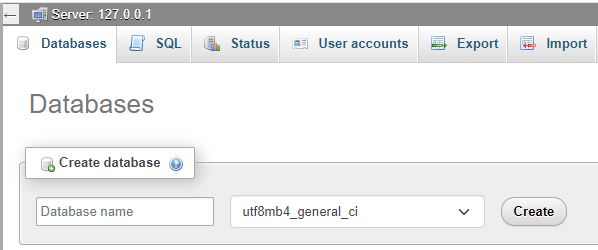
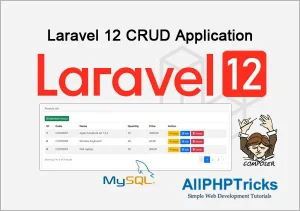
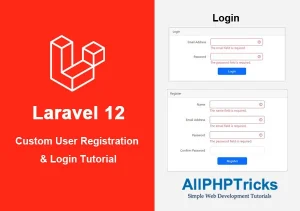
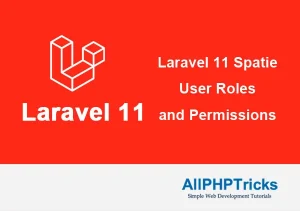
Fantastic! The code works perfectly, the readme.md instructions are simple and precise. Compliments!
Dear Rinata,
I am glad to know that you find this tutorial helpful.
it has helped me too
Glad to know that you found it helpful. 🙂
Do you have similar tutorial for setting up Laravel to a Linux server?
Dear Ken,
It does not matter which server you are using, all you need to run Laravel 11 is PHP 8.2 and any database such as MySQL. You can follow my tutorial and download xampp which will provide you required stuff.